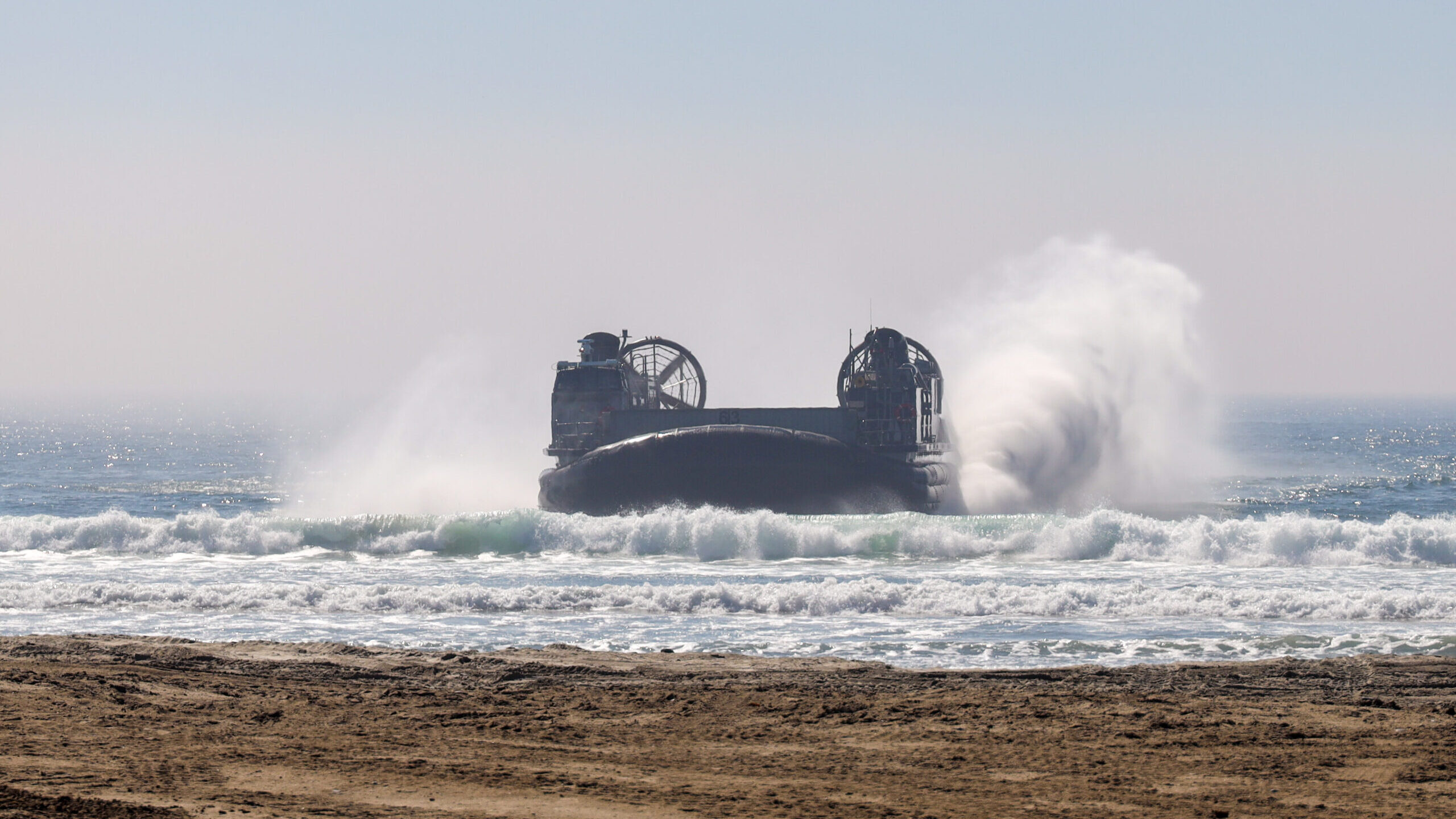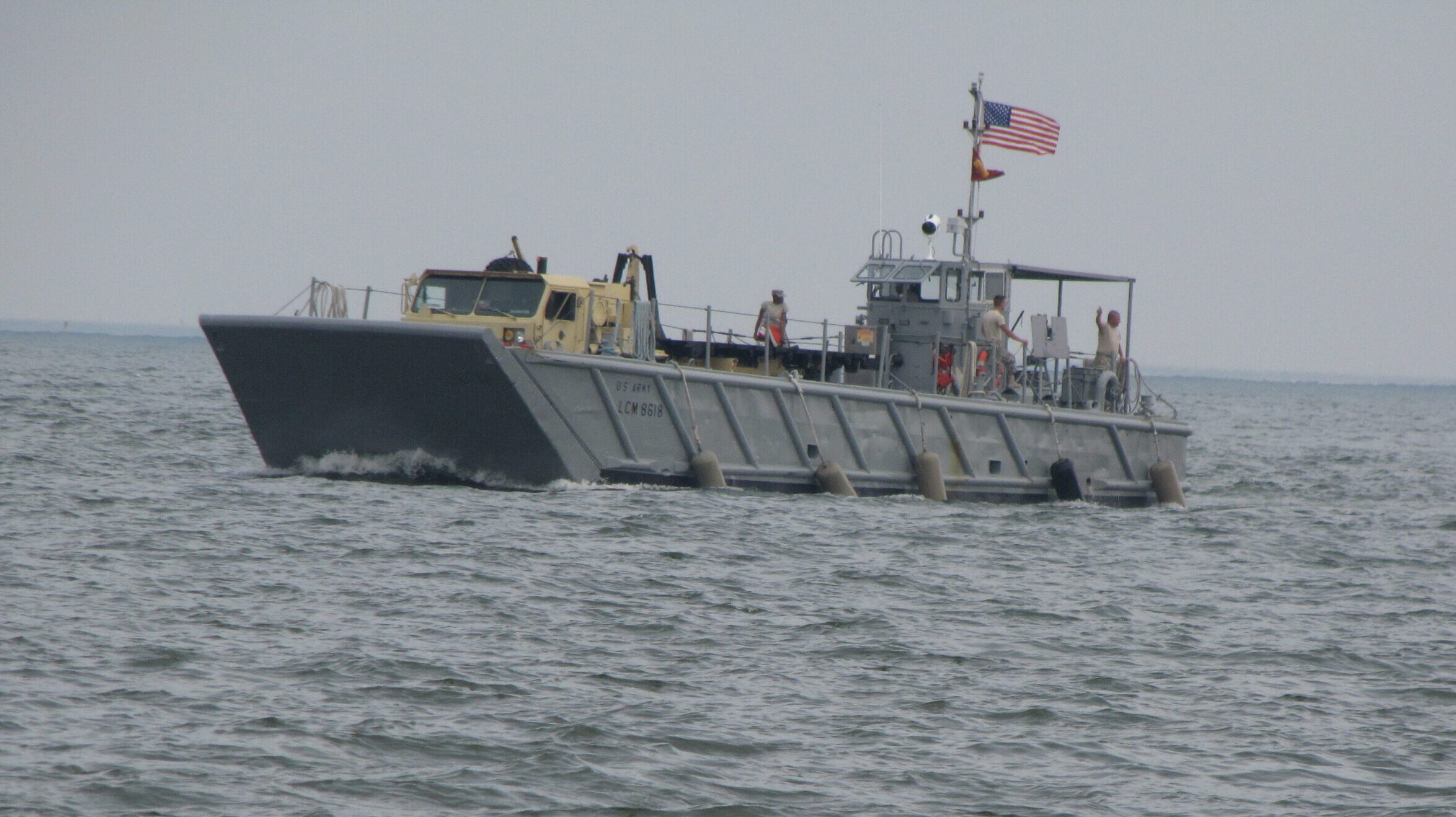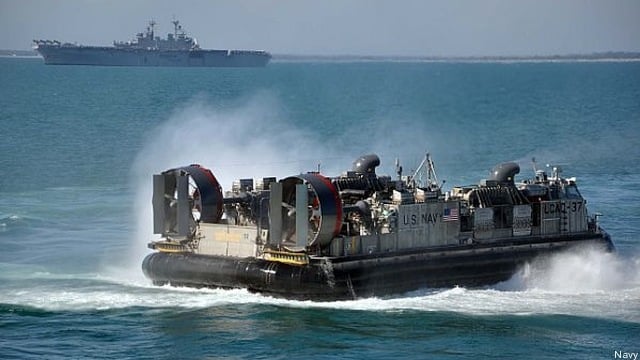JUSTIN KATZ

A Landing Craft Air Cushion (LCAC) approaches Red Beach during Project Convergence 2022 (PC22) at Marine Corps Base Camp Pendleton, Calif. (U.S. Marine Corps photo by Sgt. Juan Magadan)
WASHINGTON — Amid the US Navy’s hyperactive interest in advancing unmanned maritime drones, the Marine Corps has been developing an autonomous navigation kit built specifically for closing the critical “last mile” where amphibious watercraft meet cluttered, rough beaches — areas especially vulnerable during combat.
The effort has been dubbed the “Autonomous Littoral Connector,” and while its mission is harder than it sounds, the tech is wading towards operational use, according to exclusive interviews with officials from the forward-leaning Marine Corps Warfighting Laboratory.
“It’s [making it through] that last mile with as little risk as possible, knowing that we’ll be in a contested environment,” Lt. Col. Timothy Smith, an officer at MCWL overseeing the program, told Breaking Defense. The whole premise of the Autonomous Littoral Connector is “about reducing risk, and that means people.”
Imagine any amphibious watercraft in the Navy’s inventory having been loaded up with supplies and deployed from a dock landing ship with the coast visible just over the horizon. The craft’s driver expertly dodges sandbars and other vessels as it approaches the beach where the pilot will keep the craft steady while Marines unload the supplies. Once empty, the craft is turned around and makes the same journey back to its ship.
Because of the shallow water dangers involved, it’s a daunting task for skilled human pilots, doubly so in combat situations. Dawn Dahn, the lead engineer for the program at the MCWL, summed up the challenge succinctly: “Flat bottom boats are hard to drive… They’re really hard to drive,” she told Breaking Defense earlier this month.
But what if the driver wasn’t there at all? Instead, what if he or she is replaced with autonomous navigation software? That is the ALC in a nutshell.
The system is a combination of software and specific sensors placed in the boat that, working together, can navigate a watercraft through this journey in place of a human driver. And Smith and Dahn say the package in its end state will be able to go on just about any type of boat the Navy might choose.
Now, after years in development and successful beaching attempts during events such as the Navy’s Large Scale Exercise and DEFENDER-Europe, the officials say their autonomous navigation kit is “nearing” the point it could be transitioned into a larger program of record — if service brass decide to go along for the robotic ride.
Marine Corps Commandant Gen. Robert Neller (right) and Chief of Naval Operations John Richardson together at a previous WEST conference. (U.S. Marine Corps photo by Staff Sgt. Gabriela Garcia)
A Somewhat Prophetic Meeting
As Smith and Dahn tell it, the ALC program began around the end of 2015, when officials from MCWL, the Marine Corps’ chief research agency for developing warfighting technology, met at the Office of Naval Research for a briefing. During that meeting, the participants concluded not enough attention was being paid to moving supplies through “the last mile,” the stretch of shallow waters that sit between a warship and the coastal beaches where Marines must reach. And so, the marching orders were clear: Go find alternative methods for doing just that.
That meeting and the decision to renew their focus on “contested” spaces turned out to be prophetic. Then-Marine Corps Commandant Gen. Robert Neller, who served as the senior Marine between 2015 and 2019, in his last two years as commandant would push the service to pay greater attention to what was eventually named “Littoral Operations in a Contested Environment.” Alongside this new operational concept, Neller began delivering the message to his force that Marines could no longer assume they’ll get a reliable ride to the next battlefield.
As Neller put it, Marines will “have to fight to get to the fight.” The ALC, as envisioned, would give commanders the ability to resupply their forces without having to risk the lives of personnel usually required to make the journey from ship to shore and back again.
Happening elsewhere around this time, a new unmanned surface vessel was taking shape. This USV’s mission would be focused on long-distance, deep-water transits with minimal human intervention and carrying a variety of mission payloads. Its name would change over the years as it passed hands from research agency to research agency, but the Marine Corps officials tasked with developing the Autonomous Littoral Connector would take notice of “Sea Hunter” and the powerful autonomous navigation software upon which it relied.

The unmanned ships Seahawk, front, and Sea Hunter launch for the Pacific Fleet’s Unmanned Systems Integrated Battle Problem 21. (US Navy photo)
‘The Mike Boat’
With a signed agreement hashed out in 2016 between the Marine Corps Warfighting Lab and the Office of Naval Research, work could begin in earnest.
Dahn said one of the team’s “marching orders” was to work hand-in-hand with the Navy on whatever solution was chosen, and so the team began meeting with various units in the fleet before eventually presenting the concept for the ALC to MCWL’s commanding general, along with other options. The general picked ALC.
With the choice to endeavor into autonomous navigation made, Dahn’s office started working with “The Mike Boat,” also called LCM-8.
That vessel, better known for its time in use by the Army and Navy during the Vietnam war, is a 75-foot “Landing Craft, Mechanized,” with the infamously difficult-to-drive “flat bottom.” The craft’s name comes from the military’s phonetic alphabet “Lima Charlie Mike.”

A 7th Transportation Brigade (Expeditionary) landing craft mechanized (LCM) transports a vehicle to the shore at Fort Story, Va., on Aug. 25. (DVIDS)
Eventually the team would also fund efforts to install autonomy packages on two Landing Craft Utility vessels, a more modern ship class the Navy has favored in recent years for moving supplies from ship to shore. LCUs are roughly 139 feet-long, 31 feet-wide and displace 428 long tons when fully loaded, according to Navy statistics.
“But the reality of it is from the MCWL perspective, the actual autonomy is platform agnostic,” said Smith. “We view this as it could be matured and ride on any surface craft in the future. It doesn’t have to be a Mike Boat. It doesn’t have to be an LCU.”
Because the team behind ALC was already interested in the autonomy package aboard Sea Hunter, it made sense to work with Leidos, the vessel’s prime contractor. By this time, Smith said, the autonomy software on Sea Hunter, which would eventually make headlines for its autonomous long-distance trips, had been in development at the Defense Advanced Research Projects Agency for roughly a year and would soon transition to ONR, where it remains today. Dahn said the service began working with Leidos in fiscal year 2017.
Leidos officials confirmed the company’s involvement with the Autonomous Littoral Connector program to Breaking Defense, but deferred specific questions about the project and its progress to the Marine Corps.
The Devil Is In The Sandbars
Dahn said the work already done on Sea Hunter’s autonomy software had given them a starting point for a vessel that could follow COLREGs, the international maritime standards used to prevent collisions at sea. But there was much work to be done before it would suit the Marines’ purposes.
For example, any vessel that ventures near shallow waters must be aware of sandbars. If a future craft equipped with the ALC is to be successful, it needs to differentiate between when it hits the beach or if it’s just touching a stray, shallow patch of sand.
Another obstacle for the team was even something as innocuous as the beach sand itself. The surfaces of different beaches have different properties, and that matters when watercraft drivers are trying to “stick the beach,” Dahn said. By that she meant when the craft pulls up close enough to the coast to gain traction with the land.
And one of the challenges, for which Dahn said she gives watercraft drivers tremendous credit, is the ability to keep the boat on the beach and in place long enough for personnel to unload supplies while the waves and currents try to dislodge it.
“The engines are water-cooled, so you can’t just keep revving the engines to keep it on the beach as vehicles are driving off and shifting the ramps,” she said. “We have a whole algorithm that we had to create…to recognize [when] the boat was shifting too much to then run the engines to re-stick the beach.”

Navy LCAC hovercraft like this are another amphibious craft the service uses to carry vehicles, supplies, and heavy equipment ashore. (U.S. Navy photo by Mass Communication Specialist 1st Class Edwin F. Bryan)
Dahn and Smith didn’t elaborate on the solutions for each problem, but the obstacles they described collectively illustrate that the challenges for autonomous and unmanned vessels that remain in open, deep blue water are vastly different from those trying to maneuver in shallow, littoral zones.
They also emphasized that they have stuck to their marching orders to stay close to the Navy. The boats they’ve used, the LCM-8 and the LCUs, have all been modified by the service and its craft masters and coxswains act as safety officers when needed.
“So, engineers don’t control this boat. The Navy does,” said Dahn. “The Navy’s adopted us and brought us into their family and it really helped us with how to mature it, how to do it, because we have the input… and the feedback from the Navy every time that we go out.”
That close relationship to the Navy may become more important moving forward if ALC is to ever leave the Marine Corps’ research and development enterprise.
Rougher Waters Ahead?
Perhaps even more difficult than the transition from “ship to shore” is the change from experimental efforts to a program of record in the Pentagon’s books.
It’s hard because it requires a service, in this case most likely the Navy, to establish a formal need for the technology — in the Pentagon’s nomenclature, “requirements” — and devote money outside its research and development budget to keep the effort afloat. The changeover is so infamous that acquisition professionals in the military jokingly call it the “valley of death.”
One of the ways the military’s research agencies convince service brass to embrace a new technology is with demonstrations. And on that point, Dahn and Smith said they have no shortage.
The duo said they have successfully beached during the Navy’s Large Scale Exercise 2021, DEFENDER-Europe 2021, as well as an ONR-led exercise dubbed the Technology Operational Experimentation Exercise 2022 held at Camp Lejune.
“We’ve hit beaches in Camp Lejune. We’ve autonomously beached here [the Norfolk, Va. area] in about three different locations with different types of surface soil,” said Dahn. “We’ve also autonomously beached in Albania… during Defender Europe… The boat was allowed to interact and integrate with the UK and US ships to do ship to shore missions.”
When asked when ALC might transition from a research endeavor to a program of record, Smith was careful not to step out in front of Marine Corps leadership. “We’re nearing the ability in the next few years to transition this if the Marine Corps or the Navy establishes a requirement — we would be able to offer this as a [technology that] probably meets the requirement.”
At the end of the day, the Marine Corps Warfighting Laboratory’s mission is to design new technologies that may be of use to the service in its future fight. Whether the current chief of naval operations or commandant decides to use any given gadget or widget is out of Smith’s and Dahn’s hands.
But even if this particular program isn’t picked up, that’s not to say their work could all be for nothing. The Navy and Marine Corps have expressed clear interest in autonomous and unmanned vessels in recent years, and there’s little reason to think that will change short-term. Dahn said she hopes that if nothing else, the work done on the Autonomous Littoral Connector will be added to the Pentagon’s collective knowledge on how to design autonomous and unmanned craft in the future.
“Personally, I’m hoping that we’re learning things here that are really going to help the Navy and the Marine Corps as they do build or design things going forward… so you can have these optionally manned boats and systems [to help the service] be more effective and safe,” she said.
No comments:
Post a Comment